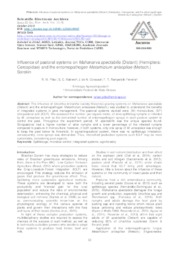Influence of pastoral systems on Mahanarva spectabilis (Distant) (Hemiptera: Cercopidae) and the entomopathogen Metarhizium anisopliae (Metsch.) Sorokin.
Influence of pastoral systems on Mahanarva spectabilis (Distant) (Hemiptera: Cercopidae) and the entomopathogen Metarhizium anisopliae (Metsch.) Sorokin.
Author(s): PITTA, R. M.; MATIERO, S. C.; CORASSA, J. de N.; RAMPELOTTI-FERREIRA, F. T.
Summary: The influence of Urochloa brizantha (variety Marandu) grazing systems on Mahanarva spectabilis (Distant) and the entomopathogen Metarhizium anisopliae (Metsch.) was studied to understand the benefits of integrated systems in pest management. The pastoral systems studied were: (M) monoculture, (SP) silvopastoral and (ICLF). We assessed the number, per square meter, of alive spittlebug nymphs or infected by M. anisopliae as well as the demanded number of entomopathogen sprays in each pasture system to control the pest. Throughout the experiment period, M. spectabilis was the unique species found. Silvopastoral had a higher number of alive nymphs and a lower percentage of the infected nymphs compared to pasture in monoculture; however, in both systems, only one spray of M. anisopliae was enough to keep the pest below its threshold. In agrosilvopastoral system, there was no spittlebugs infestation, consequently, none sprays was demanded. Thus, intensified production systems such ICLF may be more sustainable, considering pest aspects.
Publication year: 2019
Types of publication: Journal article
Observation
Some of Embrapa's publications are published as ePub files. To read them, use or download one of the following free software options to your computer or mobile device. Android: Google Play Books; IOS: iBooks; Windows and Linux: Calibre.
Access other publications
Access the Agricultural Research Database (BDPA) to consult Embrapa's full library collection and records.
Visit Embrapa Bookstore to purchase books and other publications sold by Embrapa.

